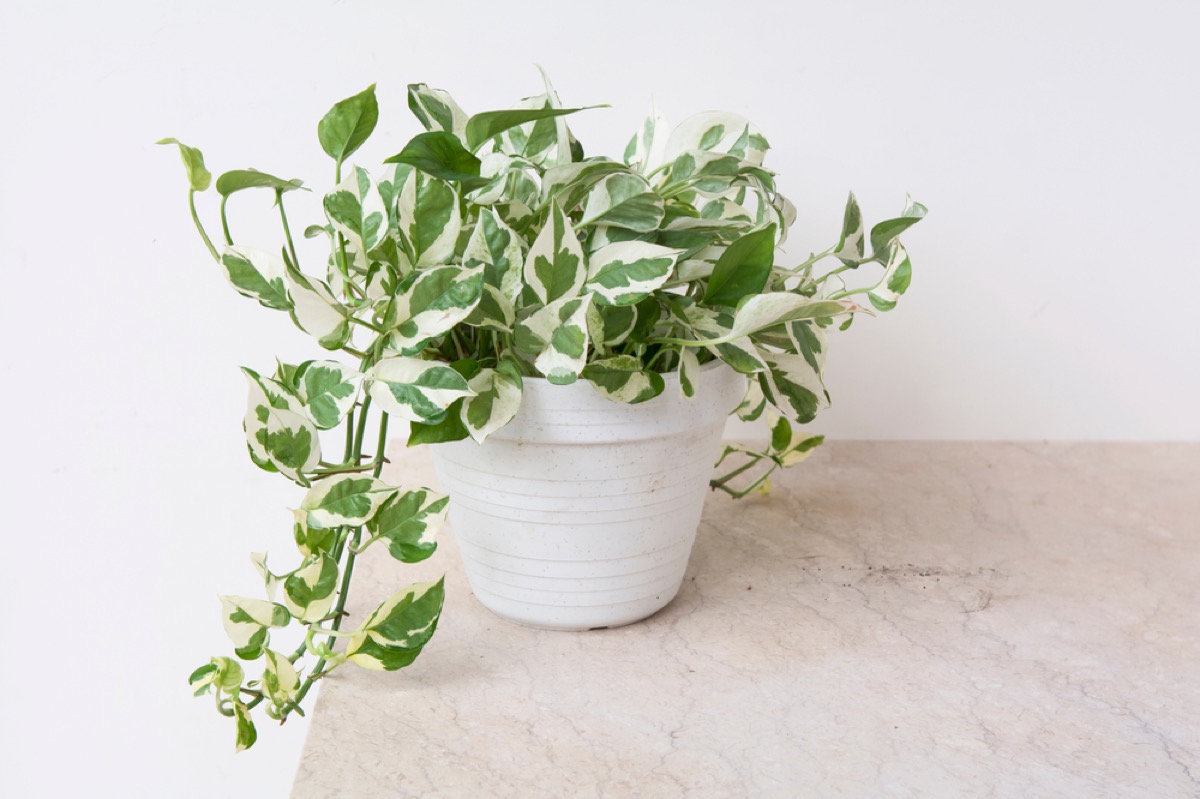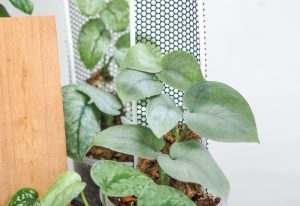Pothos plants are renowned for their easy care and lush foliage, making them a popular choice for indoor gardening. However, have you ever wondered how these plants grow and thrive? In this article, we’ll uncover the secrets of how pothos grows and what you can do to help your plant flourish.
Pothos Growth Basics
Light Requirements
Pothos plants are quite adaptable with regards to light, but they flourish best in bright, indirect light. Too much direct sunlight can cause leaf burns, while low light may inhibit growth. If your pothos is provided with optimal light, it will display vigorous growth, producing dense leaves and stems.
Water and Soil Requirements
Water is essential for pothos growth, but it’s crucial not to overwater. Allow the soil to dry slightly between waterings to avoid root rot. Pothos plants can grow in various pots, such as plastic, ceramic, metal, and terra cotta, as long as the pot has good drainage holes. When repotting, select a pot no more than two inches wider and deeper than the root ball.
For soil, choose a high-quality, well-draining potting mix that retains moisture but allows excess water to drain effectively. This will promote healthy growth and prevent potential issues caused by poor drainage.
Temperature and Humidity
Pothos plants thrive in temperatures between 75-80°F, and their growth may slow down considerably if temperatures drop below 70°F. Maintaining a humidity level above 70% is optimal for the plant. Keep your pothos away from drafty windows or vents that could cause fluctuations in temperature.
To maintain humidity, you can place a tray of water and pebbles beneath the pot, use a spray bottle to mist the leaves daily, or invest in a humidifier. Ensure your pothos plant is placed away from direct heat sources, such as radiators or heating systems, as this can negatively affect its growth.
Overall, providing your pothos plant with proper light, water, soil, temperature, and humidity requirements will result in a healthy and thriving plant. By following these guidelines, you’ll create an environment where your pothos can reach its full growth potential.
Propagation Methods
There are several methods for propagating pothos plants, which include taking cuttings and growing them in water, soil, or another medium. In this section, we will explore three popular methods: the Cutting Method, Water Propagation, and Soil Propagation.
Cutting Method
The first step in any pothos propagation method is selecting a healthy parent plant and taking an appropriate cutting. To do this, you’ll need to:
- Disinfect tools such as scissors and/or pruners beforehand.
- Choose a healthy, mature pothos plant.
- Take a 4-6 inch cutting from the plant, making sure to cut below a node.
These cuttings can then be used in the following propagation methods.
Water Propagation
The water propagation method is a popular choice because of its simplicity and ease. To propagate pothos in water, follow these steps:
- Place the cut end of the stem in a jar or glass that’s water-filled.
- Ensure that the cutting gets plenty of indirect light, but avoid direct sunlight.
- Wait around 3 to 8 weeks for roots to develop, and change the water regularly to keep it fresh.
Once the roots have developed, you can transplant the cutting into a pot with soil.
Soil Propagation
Soil propagation is another method for growing new pothos plants from cuttings. To do this, follow these steps:
- Prepare a planting container with all-purpose potting soil.
- Stick the cutting in the soil, with at least one node beneath the soil surface.
- Place the container in a location with bright indirect sunlight.
- Keep the soil consistently moist, but not overly wet.
In approximately 3 to 8 weeks, you should begin to see new growth, indicating that the cutting has successfully rooted in the soil.
By using these propagation methods, you can successfully grow new pothos plants and expand your collection.
Common Pothos Issues
In this section, we will discuss some of the most common issues that affect pothos plants: yellow leaves and root rot.
Yellow Leaves
One of the most widespread issues with pothos plants is the occurrence of yellow leaves. Yellowing can have several causes:
- Overwatering: Providing too much water can lead to yellow leaves as it creates a soggy environment, promoting root rot and depriving the plant of oxygen. To avoid this, ensure that the top few inches of soil are dry before watering again.
- Underwatering: Insufficient watering can also cause yellow leaves. Pothos needs to be watered more frequently during warmer seasons than in colder months.
- Lack of humidity: Pothos plants prefer a humid environment, and lack of humidity can cause the leaf tips to brown and the leaves to turn yellow. You can increase humidity by using a humidifier, placing a tray with water nearby or grouping the plants together.
- Exposure to direct sunlight: Pothos leaves can turn brown or yellow when exposed to direct sun because the light is too harsh for the plant. Move the pothos to a shadier location to prevent further damage.
- Nutrient deficiencies: Yellow leaves may also be a sign of nutrient deficiencies, such as nitrogen or magnesium. Use a quality all-purpose fertilizer to address any nutritional imbalances.
Root Rot
Root rot is another common issue affecting pothos plants. It is usually caused by overwatering, resulting in soggy soil that encourages the growth of harmful fungi and bacteria. Some symptoms of root rot include:
- Wilting, even when the plant has enough water
- Yellow or brown leaves
- A foul smell from the soil
- Black, mushy roots
To tackle root rot, it is important to trim away the affected roots and repot the plant in fresh soil. Make sure you choose a well-draining potting mix and monitor the plant’s watering needs closely. Keep the pothos in a well-ventilated area to discourage the growth of fungi and bacteria.
By addressing these common pothos issues, you’ll have a better chance of maintaining a healthy, happy plant. Remember that prevention is key and regular monitoring will help you catch problems before they become severe.
Pothos Varieties
Pothos, scientifically known as Epipremnum aureum, is a versatile and easy-to-grow houseplant that features many attractive varieties. In this section, we will discuss some of the popular types of pothos plants.
- Golden Pothos: Perhaps the most common variety, the golden pothos, also known as devil’s ivy or epipremnum aureum, is low-maintenance and can be grown in several environments. Its leaves display a mix of green and yellow tones, making it an eye-catching addition to any space.
- Marble Queen Pothos: With a striking cream and green variegated pattern on its leaves, the marble queen pothos can be an elegant touch to your indoor garden. It prefers medium to bright indirect light to maintain its variegation.
- Neon Pothos: This vibrant variety sports bright, solid green leaves that add a pop of color to any room. Neon pothos can thrive in both low and bright light conditions, making it a widely adaptable choice.
- Jade Pothos: Known for its deep, solid green leaves, the jade pothos is a classic choice among pothos enthusiasts. It can grow in various light conditions and is an excellent option for novice plant owners.
- Pearls and Jade Pothos: This unique variety features light green leaves with white variegation around the edges. You might also find green specks throughout the white sections. It requires medium to bright indirect light to retain its white coloring.
- N’Joy Pothos: Similar to pearls and jade, the N’Joy pothos showcases green leaves with white variegation. However, it has slightly smaller leaves and more irregular white patterning. Like its relative, it thrives in medium to bright indirect light.
In their natural habitats, pothos plants can be found climbing up tree trunks or spreading along the forest floor. Each variety can bring a unique touch to your indoor space, depending on the desired color, pattern, or growth habit. Their low-maintenance and adaptable nature make pothos plants an excellent addition to any room or beginner-friendly indoor garden.
Tips for Growing Pothos
Pothos plants are known for their easy-care nature and adaptability in various environments. To help your pothos thrive, follow these useful tips.
Firstly, it’s essential to choose the right soil for your pothos plants. They thrive in well-draining potting soil that can be on the dry side or even rocky. Additionally, ensure the soil pH is between 6.1 and 6.8, as pothos plants do well in neutral to slightly acidic conditions.
When it comes to lighting, pothos plants prefer bright indirect light. Avoid placing them in direct sunlight; instead, choose a spot with plenty of natural light but no direct sun exposure. This will help prevent scorching the leaves and maintain healthy growth.
Regarding watering, allow the pothos plant’s soil to dry out completely between waterings. Testing the soil before watering can help you gauge when it’s time to give your plant a drink. Overwatering can lead to root rot, so be mindful of your plant’s water requirements.
In terms of temperature, pothos plants prefer temperatures between 70 to 90 degrees F (21-32 C). High humidity is also beneficial, so investing in a humidifier can help create the perfect environment for your pothos to grow.
Some additional tips for growing great pothos include:
- Selecting the proper pot size
- Making your own soil mix
- Using filtered water
- Keeping your plant away from open windows
- Fertilizing with the right nutrients
- Propagating often
By following these tips and providing the appropriate care, your pothos plants are sure to thrive indoors, whether grown in soil or water. Happy planting!
Helpful Video

My name is Daniel Elrod, and I have been houseplant love ever since I was 17. I love how much joy they bring to any room in the home. I’ve always been amazed at how a few pots of flowing leaves can turn a drab and sterile office into an inviting place where people love to work at.

















































































































































































































































